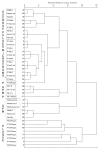A reproducible oral microcosm biofilm model for testing dental materials
- PMID: 22925110
- PMCID: PMC3501590
- DOI: 10.1111/j.1365-2672.2012.05439.x
A reproducible oral microcosm biofilm model for testing dental materials
Abstract
Aims: Most studies of biofilm effects on dental materials use single-species biofilms, or consortia. Microcosm biofilms grown directly from saliva or plaque are much more diverse, but difficult to characterize. We used the Human Oral Microbial Identification Microarray (HOMIM) to validate a reproducible oral microcosm model.
Methods and results: Saliva and dental plaque were collected from adults and children. Hydroxyapatite and dental composite discs were inoculated with either saliva or plaque, and microcosm biofilms were grown in a CDC biofilm reactor. In later experiments, the reactor was pulsed with sucrose. DNA from inoculums and microcosms was analysed by HOMIM for 272 species. Microcosms included about 60% of species from the original inoculum. Biofilms grown on hydroxyapatite and composites were extremely similar. Sucrose pulsing decreased diversity and pH, but increased the abundance of Streptococcus and Veillonella. Biofilms from the same donor, grown at different times, clustered together.
Conclusions: This model produced reproducible microcosm biofilms that were representative of the oral microbiota. Sucrose induced changes associated with dental caries.
Significance and impact of the study: This is the first use of HOMIM to validate an oral microcosm model that can be used to study the effects of complex biofilms on dental materials.
© 2012 The Society for Applied Microbiology.
Figures





Similar articles
-
Caries-related plaque microcosm biofilms developed in microplates.Oral Microbiol Immunol. 2007 Apr;22(2):73-9. doi: 10.1111/j.1399-302X.2007.00323.x. Oral Microbiol Immunol. 2007. PMID: 17311629
-
Development and pyrosequencing analysis of an in-vitro oral biofilm model.BMC Microbiol. 2015 Feb 10;15:24. doi: 10.1186/s12866-015-0364-1. BMC Microbiol. 2015. PMID: 25880819 Free PMC article.
-
Evidence of an in vitro Coupled Diffusion Mechanism of Lesion Formation within Microcosm Dental Plaque.Caries Res. 2017;51(3):188-197. doi: 10.1159/000456015. Epub 2017 Mar 1. Caries Res. 2017. PMID: 28245470
-
Does assessment of microbial composition of plaque/saliva allow for diagnosis of disease activity of individuals?Community Dent Oral Epidemiol. 1997 Feb;25(1):76-81. doi: 10.1111/j.1600-0528.1997.tb00902.x. Community Dent Oral Epidemiol. 1997. PMID: 9088695 Review.
-
Artificial dental plaque biofilm model systems.Adv Dent Res. 1997 Apr;11(1):110-26. doi: 10.1177/08959374970110010201. Adv Dent Res. 1997. PMID: 9524448 Review.
Cited by
-
Effects of glucose and lactate on Streptococcus mutans abundance in a novel multispecies oral biofilm model.Microbiol Spectr. 2024 Apr 2;12(4):e0371323. doi: 10.1128/spectrum.03713-23. Epub 2024 Feb 20. Microbiol Spectr. 2024. PMID: 38376204 Free PMC article.
-
Relevance of Biofilm Models in Periodontal Research: From Static to Dynamic Systems.Microorganisms. 2021 Feb 19;9(2):428. doi: 10.3390/microorganisms9020428. Microorganisms. 2021. PMID: 33669562 Free PMC article. Review.
-
Microcosm biofilms cultured from different oral niches in periodontitis patients.J Oral Microbiol. 2018 Nov 27;11(1):1551596. doi: 10.1080/20022727.2018.1551596. eCollection 2019. J Oral Microbiol. 2018. PMID: 30598734 Free PMC article.
-
A critical analysis of research methods and experimental models to study irrigants and irrigation systems.Int Endod J. 2022 Apr;55 Suppl 2(Suppl 2):295-329. doi: 10.1111/iej.13710. Epub 2022 Mar 6. Int Endod J. 2022. PMID: 35171506 Free PMC article. Review.
-
Protein relative abundance patterns associated with sucrose-induced dysbiosis are conserved across taxonomically diverse oral microcosm biofilm models of dental caries.Microbiome. 2015 Dec 19;3:69. doi: 10.1186/s40168-015-0136-z. Microbiome. 2015. PMID: 26684897 Free PMC article.
References
-
- Aparicio C, et al. Surface properties modification induced by sterilization of dental resin composites. J Dent Res. 2012;91 (Spec Iss A):1200.
-
- Auschill TM, et al. The effect of dental restorative materials on dental biofilm. Eur J Oral Sci. 2002;110:48–53. - PubMed
-
- Azevedo MS, et al. Microcosm biofilms originating from children with different caries experience have similar cariogenicity under successive sucrose challenges. Caries Res. 2011;45:510–517. - PubMed
Publication types
MeSH terms
Substances
Grants and funding
LinkOut - more resources
Full Text Sources
Research Materials

